Haben Sie jemals auf einen Link geklickt und dann die Fehlermeldung „Seite nicht gefunden“ erhalten? Das ist frustrierend für Besucher und kann sich negativ auf das Ranking Ihrer Website auswirken.
Wenn Sie eine URL ohne Weiterleitung ändern, behandeln Suchmaschinen sie als komplett neue Seite. Das bedeutet, dass Sie die SEO-Autorität verlieren, die Sie im Laufe der Zeit aufgebaut haben.
Bei WPBeginner verwenden wir All in One SEO, um unsere Weiterleitungen zu verwalten. Dies stellt sicher, dass unsere Leser immer auf den richtigen Inhalt gelangen und hält unsere Website gesund.
In diesem Leitfaden zeigen wir Ihnen, wie Sie 301-Weiterleitungen in WordPress erstellen. Wir behandeln anfängerfreundliche Plugins und manuelle Methoden, damit Sie die beste Option für Ihre Website wählen können.

Was ist eine Weiterleitung in WordPress?
Eine Weiterleitung ist eine Möglichkeit, Ihre Website-Besucher automatisch von einer URL zu einer anderen zu senden. Stellen Sie es sich wie eine Nachsendeadresse bei der Post vor. Wenn jemand versucht, Ihre alte Seite zu besuchen, leitet die Weiterleitung ihn sofort und ohne Aufwand an den neuen Standort weiter.
So funktioniert es: Wenn ein Besucher auf einen Link klickt oder eine URL eingibt, die nicht mehr existiert, greift die Weiterleitung und leitet ihn nahtlos zur richtigen Seite weiter. Dies geschieht so schnell, dass die meisten Benutzer nicht einmal bemerken, dass sie weitergeleitet wurden.
Es gibt verschiedene Arten von Weiterleitungen, die jeweils durch einen dreistelligen Code wie 301, 302 oder 307 identifiziert werden. Die 301-Weiterleitung ist jedoch bei weitem die wichtigste für WordPress-Benutzer.
Eine 301-Weiterleitung teilt sowohl Browsern als auch Suchmaschinen mit, dass eine Seite dauerhaft an einen neuen Ort verschoben wurde, und überträgt fast den gesamten SEO-Wert der ursprünglichen Seite auf die neue URL.
Dies ist wichtig, da Sie Ihre Suchmaschinen-Rankings nicht verlieren, wenn Sie Inhalte auf Ihrer WordPress-Website verschieben oder neu organisieren. Stattdessen wird all dieser hart erarbeitete SEO-Wert und die Autorität der Suchmaschinen an Ihre neue Seite weitergegeben.
Jetzt, da Sie verstehen, was Weiterleitungen sind und warum 301-Weiterleitungen so leistungsfähig sind, betrachten wir die spezifischen Situationen, in denen Sie sie verwenden müssen.
Wann benötigen Sie eine 301-Weiterleitung in WordPress?
Zu verstehen, wann 301-Weiterleitungen verwendet werden müssen, kann Ihnen auf lange Sicht große SEO-Probleme ersparen. Hier sind die häufigsten Szenarien, in denen Sie sie benötigen werden:
- Seiten verschieben oder löschen: Wenn Sie eine Seite entfernen oder an einen neuen Ort verschieben, stellt eine 301-Weiterleitung sicher, dass Besucher nicht auf eine Sackgasse stoßen. Stattdessen werden sie automatisch zur relevantesten Ersatzseite weitergeleitet.
- Permalinks ändern: Wenn Sie Ihre Permalink-Struktur aktualisieren oder die URL eines Beitrags umbenennen, stellen Weiterleitungen Ihre Suchrankings sicher und vermeiden, dass bestehende Links kaputtgehen.
- Konsolidierung ähnlicher Inhalte: Wenn Sie mehrere Seiten haben, die dasselbe Thema behandeln, können Sie diese zu einer umfassenden Seite zusammenführen und die alten URLs auf den neuen, stärkeren Inhalt weiterleiten.
Ohne entsprechende Weiterleitungen stoßen Besucher auf eine 404-Fehlerseite , wenn sie versuchen, auf verschobene oder gelöschte Inhalte zuzugreifen. Dies führt zu einer frustrierenden Benutzererfahrung.
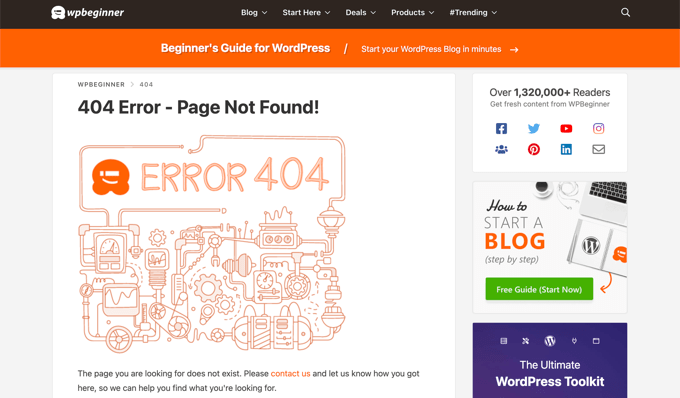
Schlimmer noch, defekte Links können Ihre WordPress SEO ernsthaft beschädigen. Suchmaschinen betrachten zu viele 404-Fehler als Zeichen schlechter Website-Wartung, was Ihre Rankings beeinträchtigen kann.
Sie verlieren auch wertvolle Backlinks und die Autorität, die sie bieten, wenn externe Websites auf Seiten verlinken, die nicht mehr existieren.
Die gute Nachricht? 301-Weiterleitungen lösen all diese Probleme, indem sie Besucher, Suchmaschinen und Linkautorität nahtlos von Ihren alten URLs auf Ihre neuen übertragen. Dies bewahrt Ihre Keyword-Rankings und sorgt dafür, dass Ihre Website reibungslos läuft.
Jetzt, da Sie verstehen, warum 301-Weiterleitungen unerlässlich sind, tauchen wir in den praktischen Teil ein. Wir zeigen Ihnen mehrere einfache Methoden, um Weiterleitungen in WordPress zu erstellen, von anfängerfreundlichen Weiterleitungs-Plugins bis hin zu manuellen Code-Lösungen für fortgeschrittene Benutzer.
- Erstellen von 301-Weiterleitungen mit dem AIOSEO-Plugin
- 301-Weiterleitungen mit dem Redirection-Plugin erstellen
- Erstellen von 301-Weiterleitungen mit dem Plugin „Simple 301 Redirects“
- Weiterleitung bestehender Seiten mit dem Plugin „Seitenlinks zu“
- Manuelles Erstellen von 301-Weiterleitungen mit .htaccess
- Video-Tutorial
- Häufig gestellte Fragen zu 301-Weiterleitungen
- Zusätzliche Ressourcen
Methode 1: 301-Weiterleitungen mit dem AIOSEO-Plugin erstellen
Der einfachste Weg, 301-Weiterleitungen zu verwalten und zu erstellen, ist mit dem All in One SEO (AIOSEO) WordPress-Plugin. Es ist das beste SEO-Plugin für WordPress und wird von über 3 Millionen Profis verwendet, um das SEO ihrer Website zu verbessern.
AIOSEO bietet ein leistungsstarkes Add-on für den Weiterleitungsmanager, mit dem Sie ganz einfach defekte Links auf Ihrer Website finden und 301-Weiterleitungen einrichten können, um sie zu beheben.
Hinweis: Sie benötigen AIOSEO Pro, um den Weiterleitungsmanager zu verwenden. Es gibt auch eine kostenlose Version von AIOSEO, aber diese beinhaltet keine 301-Weiterleitungen.
Zuerst müssen Sie das AIOSEO Pro-Plugin auf Ihrer Website installieren und konfigurieren. Weitere Informationen finden Sie in unserer Schritt-für-Schritt-Anleitung, wie Sie All in One SEO korrekt einrichten.
Sobald das Plugin aktiv ist, müssen Sie in Ihrem WordPress-Dashboard zu All in One SEO » Redirects gehen und dann auf die Schaltfläche „Redirects aktivieren“ klicken.
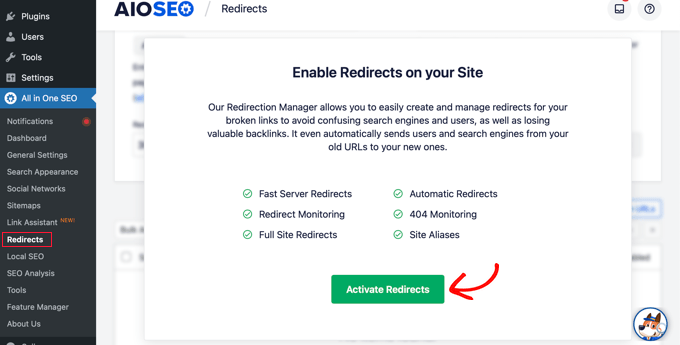
Als Nächstes können Sie auf den Tab 'Einstellungen' klicken und 'PHP' als Weiterleitungsmethode auswählen.
Dies ist die einfachste Methode zum Erstellen von Weiterleitungen und erfordert keine serverseitige Konfiguration.
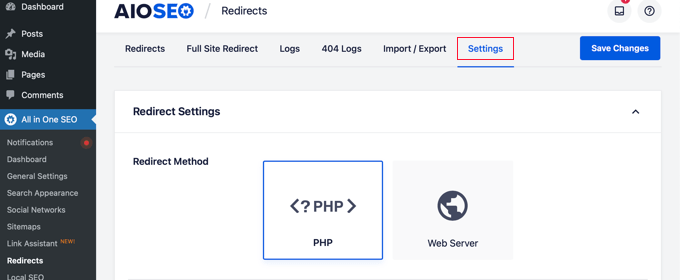
AIOSEO ermöglicht es Ihnen auch, die Webserver-Umleitungsmethode auszuwählen. Dies erfordert jedoch die Konfiguration von Apache oder NGINX auf Ihrem Webserver. Dies erfordert technisches Wissen und wird für Anfänger nicht empfohlen.
Erstellen von 301-Weiterleitungen
Jetzt sind Sie bereit, 301-Weiterleitungen zu erstellen. Gehen Sie dazu zum Reiter „Weiterleitung“.
Zuerst müssen Sie den Link eingeben, den Sie weiterleiten möchten, in das Feld 'Source URL'. Danach sollten Sie das neue Ziel für den Link in das Feld 'Target URL' eingeben.
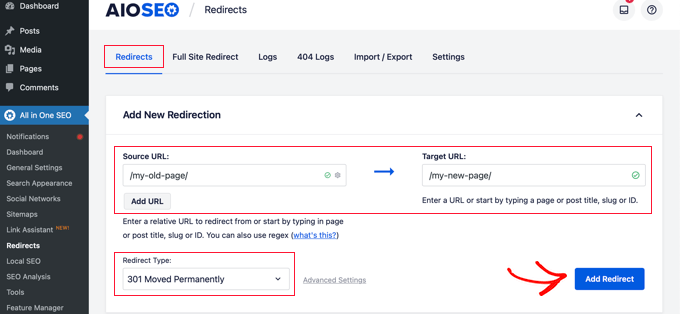
Stellen Sie nun sicher, dass der Weiterleitungstyp auf „301 Moved Permanently“ (301 dauerhaft verschoben) eingestellt ist, und klicken Sie dann auf die Schaltfläche „Add Redirect“ (Weiterleitung hinzufügen).
Wenn Sie mehrere URLs an einen neuen Speicherort weiterleiten möchten, klicken Sie einfach unter dem Feld „Quell-URLs“ auf die Schaltfläche „URL hinzufügen“.
Als Nächstes können Sie nach unten scrollen, um die Protokolle der von Ihnen erstellten Weiterleitungen anzuzeigen. Sie zeigt die Anzahl der Personen, die den weitergeleiteten Link besucht haben, in der Spalte „Aufrufe“ und eine Umschaltoption zum Aktivieren oder Deaktivieren einzelner 301-Weiterleitungen.

301-Weiterleitungen hinzufügen, um 404-Fehler zu beheben
AIOSEO kann Ihnen auch helfen, 404-Fehlerseiten zu verfolgen und zu beheben.
Um diese Option zu aktivieren, müssen Sie im Tab „Einstellungen“ nach unten zum Abschnitt „Weiterleitungs-Protokolle“ scrollen. Aktivieren Sie dann die Optionen für „404-Protokolle“ und „Weiterleitungs-Protokolle“.
Sie können auch den Zeitraum auswählen, für den die Protokolle aufbewahrt werden sollen. Wir empfehlen, sie für maximal einen Monat aufzubewahren, um eine reibungslose und schnelle Serverleistung zu gewährleisten.
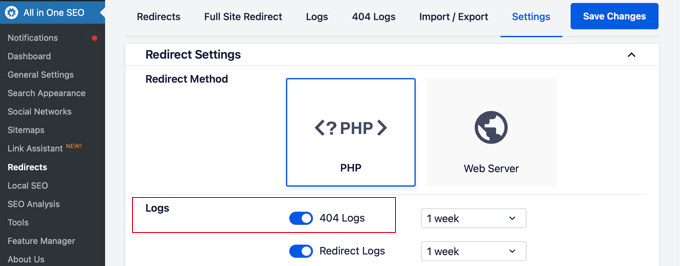
Nachdem Sie diese Optionen aktiviert haben, stellen Sie sicher, dass Sie auf die Schaltfläche 'Änderungen speichern' klicken.
Sie sollten nun einen neuen Tab namens „404-Protokolle“ im Bereich „Weiterleitungen“ sehen. Hier verfolgt und zeigt AIOSEO Ihre defekten Links an und ermöglicht es Ihnen, Weiterleitungen einzurichten. Sie sehen auch die Anzahl der Besuche des Links unter „Aufrufe“ sowie das Datum und die Uhrzeit des letzten Zugriffs.
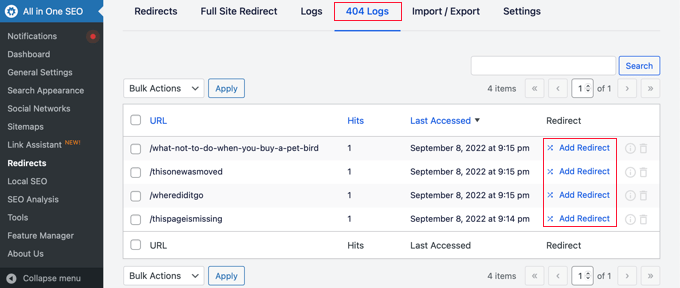
Hinweis: Sie finden keine Daten, wenn Sie die 404-Protokolle zum ersten Mal aktivieren. Das Plugin beginnt erst mit der Aufzeichnung von 404-Fehlerseiten, nachdem die Einstellung aktiviert wurde.
Klicken Sie als Nächstes auf den Link „Weiterleitung hinzufügen“ neben der 404-Fehler-URL, zu der Sie weiterleiten möchten. Dies ist nicht der Button unten.
Sie sehen nun Optionen, um eine Ziel-URL einzugeben und den Weiterleitungstyp aus dem Dropdown-Menü auszuwählen.

Geben Sie Ihre neue URL ein und wählen Sie '301 Moved Permanently' als Weiterleitungstyp. Klicken Sie nun auf die Schaltfläche 'Add Redirect'.
AIOSEO erstellt nun eine 301-Weiterleitung für Ihren defekten Link. Um zu sehen, ob die Weiterleitung ordnungsgemäß funktioniert, besuchen Sie einfach die alte URL, um zu prüfen, ob Sie zum neuen Ziel weitergeleitet werden.
301-Weiterleitungen direkt von einem Beitrag oder einer Seite hinzufügen
AIOSEO ermöglicht es Ihnen auch, einen veröffentlichten Beitrag oder eine Seite umzuleiten, während Sie ihn bearbeiten.
Wenn Sie im WordPress-Editor zum Ende der Seite scrollen, finden Sie einen Abschnitt „AIOSEO-Einstellungen“. Sie müssen auf den Tab „Weiterleitungen“ klicken.
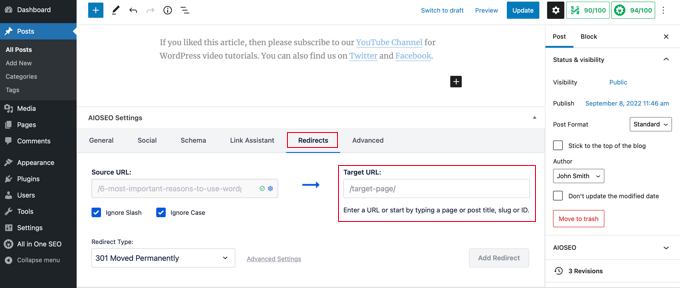
Die Quell-URL wurde für Sie ausgefüllt. Geben Sie einfach die neue URL in das Feld „Ziel-URL“ ein und wählen Sie im Dropdown-Menü „Weiterleitungstyp“ die Option „301 dauerhaft verschoben“ aus.
Wenn Sie außerdem die Permalink-Struktur eines Beitrags während der Bearbeitung ändern, bietet AIOSEO an, die alte URL auf die neue weiterzuleiten.
Klicken Sie in jedem Fall auf die Schaltfläche „Weiterleitung hinzufügen“ und Sie sind fertig.
Weiterleitung ganzer Websites
Wenn Sie Ihre Website auf eine neue Domain verschieben, können Ihre Besucher defekte Links antreffen und die SEO Ihrer Website kann darunter leiden.
Sie können AIOSEO verwenden, um Ihre gesamte Website an einen neuen Standort zu verschieben, ohne Traffic oder Suchmaschinen-Rankings zu verlieren. Dies ist eine 301-Weiterleitung der gesamten Website.
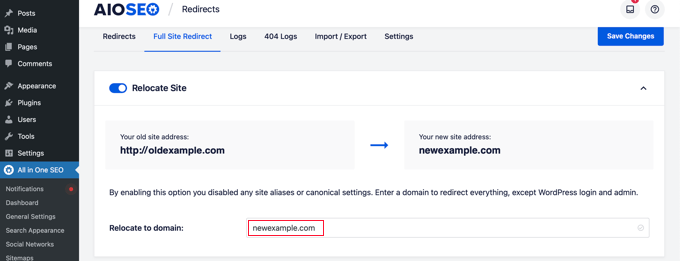
Es ist wichtig, dass Sie dies richtig machen, daher haben wir eine Schritt-für-Schritt-Anleitung für Anfänger erstellt, wie Sie eine vollständige Website-Weiterleitung mit WordPress durchführen.
Methode 2: 301-Weiterleitungen mit dem Redirection-Plugin erstellen
Eine weitere Möglichkeit, Weiterleitungen in WordPress hinzuzufügen und zu verwalten, ist das Plugin Redirection.
Zuerst müssen Sie das Plugin installieren und aktivieren. Sie können unserer detaillierten Anleitung folgen, wie man ein WordPress-Plugin installiert.
Hinweis: Obwohl die Einrichtung von 301-Weiterleitungen mit einem WordPress-Plugin einfach ist, hat dies einige geringfügige Leistungseinbußen. Abhängig von Ihrem WordPress-Hosting-Anbieter können Ihre Weiterleitungen etwas langsamer sein als bei anderen Methoden.
Wenn Sie Ihre Weiterleitungen so schnell wie möglich gestalten möchten, können Sie dies tun, indem Sie Ihre .htaccess-Datei mit Methode 5 unten bearbeiten.
Nach der Aktivierung besuchen Sie Tools » Weiterleitung und klicken dann auf die Schaltfläche „Einrichtung starten“.
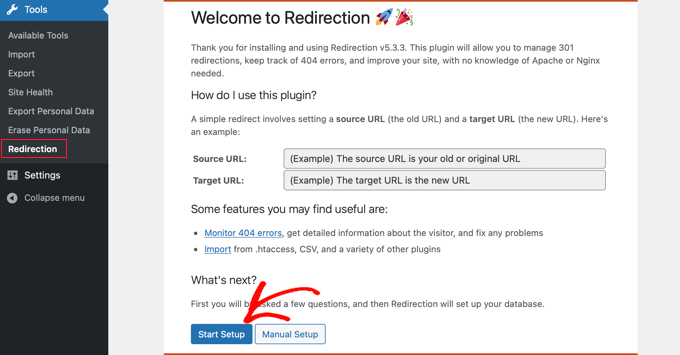
Als Nächstes können Sie Optionen auswählen, um Änderungen an Permalinks in WordPress zu überwachen und eine Protokolldatei aller Ihrer Weiterleitungen und 404-Fehler zu führen.
Sie können diese Optionen einfach aktivieren und auf die Schaltfläche 'Setup fortsetzen' klicken.
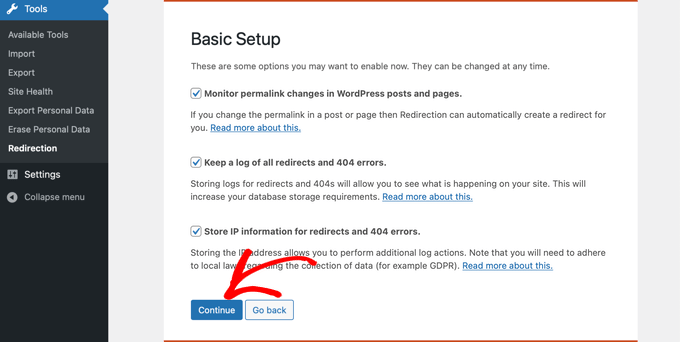
Das Plugin testet nun automatisch die Rest API.
Wenn der Status „Gut“ zurückkommt, klicken Sie auf die Schaltfläche „Einrichtung abschließen“.
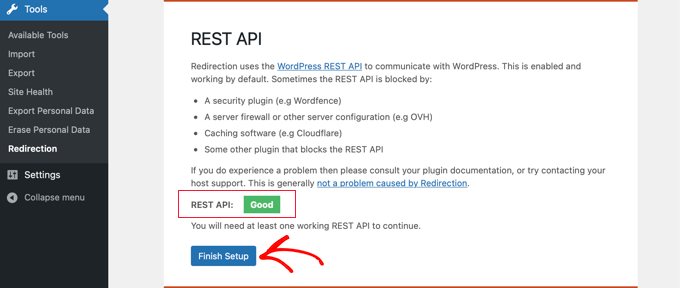
Das Weiterleitungs-Plugin führt einige weitere Aufgaben aus, um seine Einrichtung abzuschließen. Wenn die Fortschrittsanzeige 100 % erreicht, können Sie auf die Schaltfläche „Weiter“ und dann auf die Schaltfläche „Bereit zum Starten“ klicken.
Das Plugin ist nun bereit für Sie, um Ihre 301-Weiterleitungen zu erstellen. Um zu beginnen, navigieren Sie zum Abschnitt Tools » Weiterleitung in Ihrem WordPress-Panel. Sie sollten den Abschnitt 'Neue Weiterleitung hinzufügen' am unteren Bildschirmrand suchen.
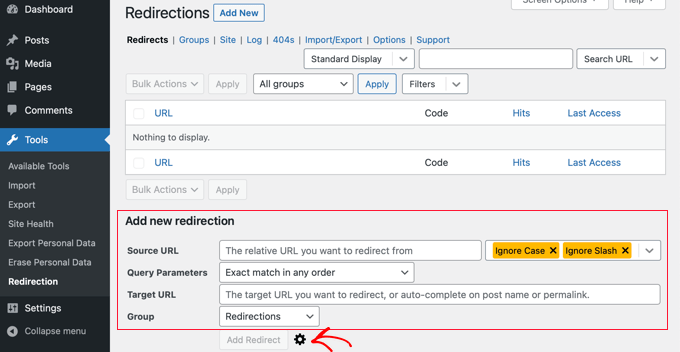
Sie sehen die Grundeinstellungen zum Hinzufügen einer Weiterleitung. Wenn Sie jedoch auf das Zahnradsymbol klicken, sehen Sie weitere Optionen, um Ihren Weiterleitungstyp auszuwählen.
Geben Sie einfach die Quell-URL Ihrer alten Seite ein und fügen Sie die „Ziel-URL“ hinzu, zu der Sie weiterleiten möchten. Sie sollten auch sicherstellen, dass die Option für den HTTP-Code auf „301 – Moved Permanently“ gesetzt ist.

Sobald Sie alle Details eingegeben haben, klicken Sie auf die Schaltfläche „Weiterleitung hinzufügen“.
Methode 3: 301-Weiterleitungen mit dem Plugin Simple 301 Redirects erstellen
Eine der einfachsten Möglichkeiten, 301-Weiterleitungen zu erstellen, ist mit dem Simple 301 Redirects Plugin. Wie der Name schon sagt, macht es 301-Weiterleitungen wirklich einfach.
Um zu beginnen, müssen Sie das Plugin installieren und aktivieren auf Ihrer Website.
Danach müssen Sie zu Einstellungen » 301-Weiterleitungen navigieren. Hier können Sie die alte URL in das Feld 'Anfrage' und Ihre Ziel-URL in das Feld 'Ziel' eingeben.

Sobald Sie dies getan haben, klicken Sie auf die Schaltfläche „Neu hinzufügen“, um die 301-Weiterleitung zu erstellen. Das war's.
Einfache 301-Weiterleitungen beginnen sofort zu funktionieren.
Methode 4: Weiterleitung bestehender Seiten mit dem Plugin „Seitenlinks zu“
Manchmal möchten Sie vielleicht auf Inhalte verlinken, die auf einer anderen Website gehostet werden, aber die Linkstruktur Ihrer eigenen Domain beibehalten. Dies unterscheidet sich vom Beheben eines defekten Links. Hier ist das Plugin Page Links To nützlich.
Hinweis: Dieses Plugin wurde seit einiger Zeit nicht mehr aktualisiert, aber in unseren Tests funktioniert es immer noch korrekt und leitet bestimmte Seiten zu extern gehosteten Inhalten weiter.
Sobald Sie das Plugin installiert und aktiviert haben, fügt es eine Meta-Box zu Ihrem WordPress-Editor hinzu. Hier können Sie die Adresse des neuen Ortes eingeben, an den Sie Ihre Benutzer senden möchten.
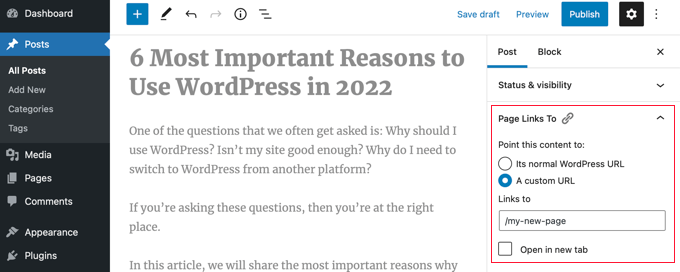
Wenn Sie auf „Aktualisieren“ oder „Veröffentlichen“ klicken, behandelt WordPress den Beitrag oder die Seite wie gewohnt, aber wenn jemand sie besucht, wird er stattdessen zu der von Ihnen gewählten benutzerdefinierten URL weitergeleitet.
Zum Beispiel haben Sie vielleicht einen Blog, auf dem Sie gelegentlich herunterladbare Inhalte erstellen, aber Benutzer auf Ihrer Online-Shop-Website möchten, dass bestimmte Beiträge als Produkte angezeigt werden. Sie können dieses Plugin verwenden, um dies zu tun, ohne das Risiko von Strafen für doppelte Inhalte von Google einzugehen oder Ihre Benutzerbasis zu spalten.
Methode 5: Manuelles Erstellen von 301-Weiterleitungen mit .htaccess
WordPress-Benutzer können 301-Weiterleitungen auch einrichten, indem sie die Webserver-Konfigurationsdatei .htaccess bearbeiten.
Bitte beachten Sie, dass ein kleiner Fehler in Ihrem .htaccess-Code Ihre WordPress-Website unzugänglich machen kann und möglicherweise die Fehlermeldung "Internal Server Error" angezeigt wird.
Deshalb ist es wichtig, dass Sie Ihre .htaccess-Datei sichern, bevor Sie Änderungen vornehmen.
Bearbeiten Sie Ihre .htaccess-Datei mit dem All in One SEO Plugin
Wenn Sie das Plugin All in One SEO installiert haben, bietet es eine einfache Möglichkeit, Ihre .htaccess-Datei zu bearbeiten.
Hinweis: Sie benötigen All in One SEO Pro, um den .htaccess-Editor zu verwenden.
Besuchen Sie einfach die Seite All in One SEO » Tools und wechseln Sie zum Tab „.htaccess Editor“.
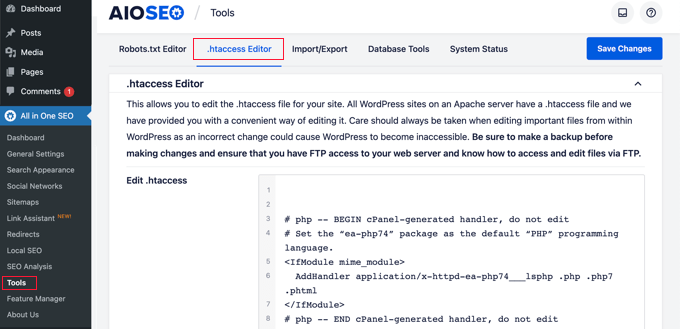
Von hier aus sehen Sie den Inhalt Ihrer .htaccess-Datei im Editor. Sie können einfach jeden Weiterleitungscode, den Sie hinzufügen möchten, am Ende nach der Zeile „# END WordPress“ einfügen.
Hier ist eine einfache Weiterleitung, bei der wir versuchen, einen Benutzer, der einen alten Beitrag besucht, zu einem neuen Beitrag zu senden.
RewriteEngine On
Redirect 301 /a-very-old-post/ http://yoursite.com/a-very-new-post/
Vergessen Sie nicht, die alten und neuen Beitrags-URLs zu ändern. Wenn Sie fertig sind, klicken Sie auf die Schaltfläche 'Änderungen speichern', um Ihre Einstellungen zu speichern, und All in One SEO aktualisiert Ihre .htaccess-Datei.
Bearbeiten Sie Ihre WordPress .htaccess-Datei direkt
Sie können auch Ihre WordPress .htaccess-Datei direkt bearbeiten, um Weiterleitungen einzurichten.
Um Ihre .htaccess-Datei zu bearbeiten, müssen Sie sich mit einem FTP-Client mit Ihrer Website verbinden. Die .htaccess-Datei befindet sich im Stammverzeichnis Ihrer WordPress-Website.
Wenn Sie Ihre .htaccess-Datei nicht sehen können, lesen Sie unseren Leitfaden Warum Sie die .htaccess-Datei auf Ihrer WordPress-Website nicht finden können.
Sie können .htaccess auf Ihren Computer herunterladen und mit einem Texteditor wie Notepad bearbeiten.
Sie können den folgenden Weiterleitungscode verwenden, um einen Benutzer, der einen alten Beitrag besucht, zu einem neuen Beitrag zu senden. Sie sollten den Code am Ende Ihrer .htaccess-Datei nach der Zeile „# END WordPress“ einfügen.
RewriteEngine On
Redirect 301 /a-very-old-post/ http://yoursite.com/a-very-new-post/
Stellen Sie sicher, dass Sie die URLs des alten und des neuen Beitrags ändern. Danach können Sie Ihre Änderungen speichern und die .htaccess-Datei zurück auf den Server hochladen.
Jetzt können Sie Ihre Weiterleitung testen, um sicherzustellen, dass sie wie gewünscht weiterleitet.
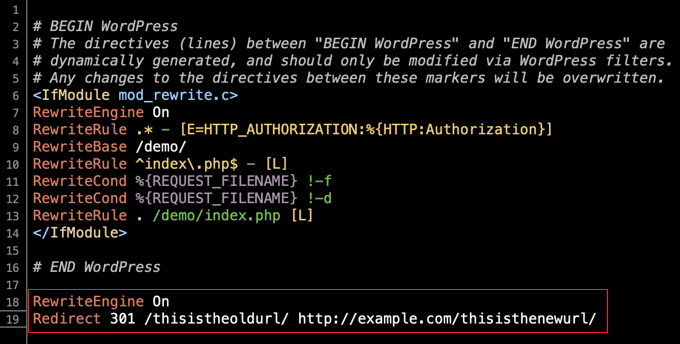
Darüber hinaus können Sie über das Dashboard Ihres Hosting-Anbieters und den integrierten Dateimanager auch auf Ihre .htaccess-Datei zugreifen und diese bearbeiten.
Zum Beispiel finden Sie Ihre .htaccess-Datei im Dateimanager von SiteGround, indem Sie zu Site Tools » Site » File Manager gehen und zu Ihrem Website-Ordner /public_html/ navigieren.
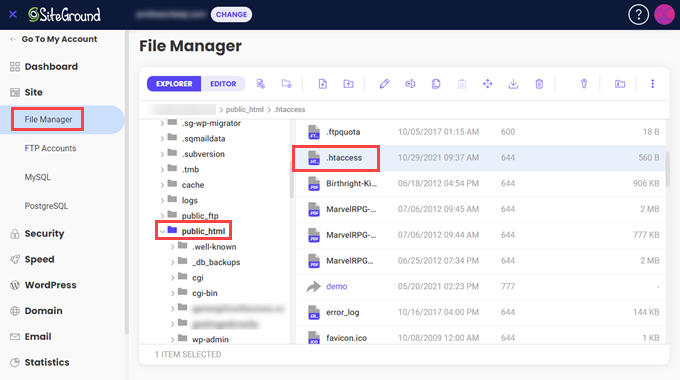
Dann können Sie mit der rechten Maustaste auf die .htaccess-Datei klicken und „Bearbeiten“ auswählen.
Profi-Tipp: Lassen Sie das Fenster Ihres Dateimanagers nach dem Speichern der Datei geöffnet. Wenn Ihre Website einen Fehler anzeigt, können Sie Ihre Änderungen sofort rückgängig machen oder Ihr Backup wiederherstellen.
Fügen Sie einfach den 301-Weiterleitungscode direkt hinzu und speichern Sie die Datei. Stellen Sie erneut sicher, dass Sie die ursprüngliche .htaccess-Datei als Backup herunterladen, um auf Nummer sicher zu gehen.
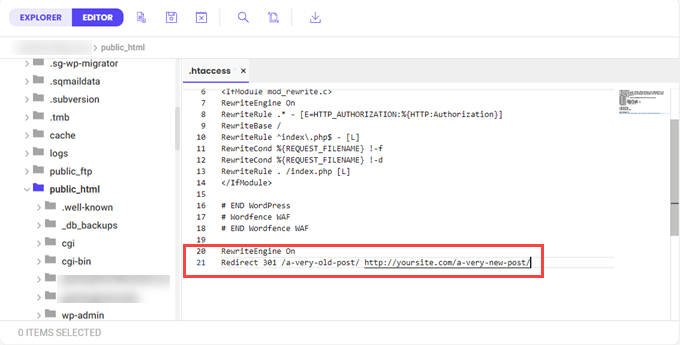
Video-Tutorial
Häufig gestellte Fragen zu 301-Weiterleitungen
Wir haben Tausenden von Benutzern geholfen, defekte Links zu beheben und Weiterleitungen einzurichten. Hier sind Antworten auf einige der häufigsten Fragen, die uns zum Erstellen von 301-Weiterleitungen in WordPress gestellt werden.
1. Was ist der Unterschied zwischen einer 301-Weiterleitung und einer 302-Weiterleitung?
Eine 301-Weiterleitung ist permanent. Sie teilt Suchmaschinen mit, dass die Seite für immer verschoben wurde und überträgt das SEO-Ranking auf die neue URL. Eine 302-Weiterleitung ist temporär. Sie teilt Suchmaschinen mit, dass die Verschiebung nur für kurze Zeit gilt, sodass sie die alte URL in ihrem Index behalten sollten. Sie sollten fast immer eine 301-Weiterleitung für defekte Links oder Inhaltsaktualisierungen verwenden.
2. Beeinflusst eine 301-Weiterleitung die SEO?
Ja, aber auf gute Weise. Wenn Sie eine Seite ohne Weiterleitung löschen, verlieren Sie deren Traffic und Suchranking. Eine 301-Weiterleitung bewahrt diese Autorität, indem sie sie an die neue Seite weitergibt.
3. Wie lange sollte ich eine 301-Weiterleitung aktiv lassen?
Sie sollten eine 301-Weiterleitung so lange wie möglich aktiv lassen. Wenn Sie die Weiterleitung entfernen, sehen alle, die auf einen alten Link von einer anderen Website klicken, einen 404-Fehler. Wir empfehlen, sie auf unbestimmte Zeit beizubehalten, da sie Ihre Website nicht wesentlich verlangsamen.
4. Kann ich eine gelöschte Seite auf meine Homepage weiterleiten?
Das können Sie, aber es wird für SEO nicht empfohlen. Google behandelt Weiterleitungen zur Homepage als 'Soft 404s', da der Inhalt nicht relevant für das ist, wonach der Benutzer gesucht hat. Es ist besser, zu einer Kategorieseite oder einem bestimmten Artikel weiterzuleiten, der eng mit dem gelöschten Inhalt verwandt ist.
5. Wie behebe ich einen Fehler 'zu viele Weiterleitungen'?
Dieser Fehler tritt normalerweise auf, wenn Sie eine Weiterleitungsschleife erstellen. Zum Beispiel leitet URL A zu URL B weiter, und URL B leitet zurück zu URL A. Um dies zu beheben, überprüfen Sie Ihre Weiterleitungseinstellungen in Ihrem Plugin oder Ihrer .htaccess-Datei und stellen Sie sicher, dass das endgültige Ziel nicht auf die ursprüngliche Quelle zurückverweist.
Zusätzliche Ressourcen
Wir hoffen, dieser Leitfaden für Anfänger zur Erstellung von WordPress-Weiterleitungen hat Ihnen geholfen, Weiterleitungen auf Ihrer Website einzurichten. Hier sind einige weitere Artikel, die Ihnen helfen, Ihre WordPress-SEO- und Website-Management-Fähigkeiten zu verbessern:
- Der ultimative WordPress SEO-Leitfaden für Anfänger (Schritt für Schritt)
- 302 Weiterleitung vs. 301 Weiterleitung – Welche sollten Sie verwenden?
- So finden und beheben Sie defekte Links in WordPress (Schritt für Schritt)
- So verfolgen und leiten Sie 404-Seiten in WordPress um
- So verschieben Sie WordPress einfach auf eine neue Domain (ohne SEO zu verlieren)
Wenn Ihnen dieser Artikel gefallen hat, abonnieren Sie bitte unseren YouTube-Kanal für WordPress-Video-Tutorials. Sie finden uns auch auf Twitter und Facebook.





Laura
Hi
Ist es möglich, eine Weiterleitung von der Wix-Plattform zu WordPress einzurichten?
WPBeginner Support
Hallo Laura,
Bitte sehen Sie sich unseren Leitfaden zum Wechsel von Wix zu WordPress an.
Admin
Hafiz Mateen Afzal
Welches Plugin ist am besten geeignet, um Weiterleitungslinks wie diese zu erstellen:
Danke
WPBeginner Support
Hallo Hafiz,
Thirsty Affiliates ist der beste Weg, um Ihre Affiliate-/Empfehlungslinks zu verwalten. Bitte lesen Sie unseren Leitfaden zum Verschleiern von Affiliate-Links in WordPress.
Admin
cipriana leme
Wie leite ich von einem kostenlosen WordPress-Blog zu einem .com-Blog weiter? Ich kann keine Plugins auf dem kostenlosen Blog installieren, wie kann ich also die Weiterleitung durchführen? Irgendwelche Ratschläge?
Danke im Voraus
Hannah
Hallo! Ich habe gerade eine Website auf Wordpress.org erstellt und alle meine Inhalte von meiner alten Website, example.wordpress.com (mit Wordpress.com), importiert. Gibt es eine Möglichkeit, alle Inhalte von dieser Website auf meine neue umzuleiten? Die von Wordpress bereitgestellten Weiterleitungsanweisungen gaben mir einen Fehler, dass die Domain bereits existiert, wahrscheinlich weil es dachte, ich würde versuchen, eine neue Domain auf Wordpress.com zu erstellen.
Mein Website-Traffic war vorher ziemlich gering, sodass jeder, der auf frühere Blogbeiträge auf meinen sozialen Kanälen klickte, zur geschlossenen Version meiner alten Website ohne Weiterleitungen gelangt wäre – keine Weltuntergangsstimmung, da ich nicht die Reichweite habe, die später Klicks generieren würde, aber man weiß ja nie?
Jeder Rat, den jemand hat, wäre großartig!
Danke,
Hannah
Senith Nal
Deine Lektion ist sehr hilfreich. Ich mag sie.
Shakoat Hossain
Brillante Lösung zur Reduzierung von Weiterleitungen für WordPress!
Seit ein paar Tagen versuche ich, meine WP-Weiterleitungsprobleme zu lösen. Ich finde keine bessere Lösung, auch nachdem ich diesen Inhalt gelesen habe.
Hier habe ich ein paar gute Punkte gefunden und versuche, Weiterleitungen zu reduzieren, um meine Seitenladezeit zu erhöhen.
Thanks!
Roshni Kanchan
Hallo,
Können Sie mir bitte sagen – bei der einfachen 301-Weiterleitung in der Spalte „Request URL“, nimmt WordPress / Plugin dies als Start von http oder https? Woher bezieht es diesen Wert?
Danke für den Artikel. Er war nützlich. Allerdings funktionieren die Weiterleitungen mit dem 301 Redirect Plugin nicht und landen auf der Seite 'Seite nicht gefunden'.
WPBeginner Support
Hallo Roshni,
Es verwendet Ihre WordPress-Site-Adresse, wie auf der Seite WordPress-Einstellungen > Allgemein definiert.
Admin
Nalin
Hallo,
Wenn ich die URL-Struktur meiner Beiträge ändern möchte, ist dann trotzdem eine Weiterleitung notwendig? Kümmert sich WP nicht bereits darum?
Wenn ich nicht weiterleite, ist das schädlich für SEO oder können Suchmaschinen die automatische Weiterleitung von WP erkennen?
Melissa
Sehr hilfreich. Vielen Dank für den Tipp. Vielen Dank, dass Sie es so einfach gemacht haben.
Melissa
Walter A.
Vielen Dank, ich hätte so viel Zeit damit verbracht, es auf dem langen Weg zu tun. Ich bin so froh, dass Redirection nach der Installation sofort funktionierte.
Cristian Adam
Hallo Wpbeginner, ich habe eine Frage zu 301 permanenten Weiterleitungen und Ihr Rat wäre großartig. Ich habe eine Website über Schnarchen und auf dieser Website gibt es 2 verwandte Artikel, von denen einer für viele Keywords auf den Positionen 2-10 rankt (Artikel A) und der andere nur für 4-5 Keywords auf den Positionen 1-3 (Artikel B). Beide Artikel sind auf der ersten Google-Seite und ich möchte Artikel B permanent auf A weiterleiten. Außerdem gibt es auf meiner Website einige Artikel, die auf Artikel B verweisen, und ich möchte, dass sie mit denselben Ankertexten auf Artikel A verweisen. Nun meine Frage: Werden diese Änderungen den Juice von Artikel B auf A übertragen und die Rankings von Artikel A erhöhen? Und wenn ich diese Änderungen vornehme, sollte ich Artikel B löschen und den Inhalt auf anderen Websites wiederverwenden? Vielen Dank für Ihre Zeit, ich warte auf Ihre Antwort, bitte entschuldigen Sie mein schlechtes Englisch.
WPBeginner Support
Hallo Christian,
Eine 301-Umleitung überträgt den Link-Juice auf den neuen Artikel. Allerdings würden auch andere Suchranking-Faktoren für den neuen Artikel gelten, wie Relevanz, Kontext, Keyword-Dichte und mehr. Suchmaschinen finden ihn möglicherweise nicht relevant für die alten Keywords.
Admin
Raj
Hallo WP beginner Team,
Eine schnelle Frage.
Letztes Jahr, als wir URLs geändert haben, leitete WordPress alte URLs automatisch zu neuen URLs um.
Aber nach einem kürzlichen WordPress Core Update erfolgt die automatische Weiterleitung nicht mehr.
Könnten Sie das erklären? Oder übersehe ich etwas?
Adebowale Adewale
Ich ändere die Domain einer WordPress-Website example.com zu example.com.ng. Ich habe mehrere 301-Weiterleitungsregeln in .htaccess ausprobiert, nur die Homepage wird weitergeleitet.
Bitte helfen Sie mir mit dem richtigen Code.
Ich habe jeden einzeln ausprobiert:
# BEGIN WordPress RewriteEngine On RewriteCond %{HTTP_HOST} ^www.example.com RewriteRule (.*) http://www.example.com.ng/$1 [R=301,L] # END WordPressund
RewriteEngine on RewriteCond %{HTTP_HOST} ^example.com [NC,OR] RewriteCond %{HTTP_HOST} ^www.example.com [NC] RewriteRule ^(.*)$ http://example.com.ng/$1 [L,R=301,NC]Nichts funktioniert für mich.
Adebowale Adewale
Vielen Dank! Ich bin sehr dankbar.
Shubham Davey
Muss ich die Domain besitzen, während ich umleite? Meine Domain läuft am 31. Juli ab und ich werde zu einer neuen Domain umleiten. Muss ich die Domain also nach dem 31. Juli besitzen, während sie umgeleitet wird?
WPBeginner Support
Hey Shubham,
Ja, Sie benötigen diese Domain, damit Ihre Weiterleitungen weiterhin funktionieren.
Admin
christian
Ich habe über 850 alte Beiträge, die ich kürzlich aus verschiedenen Gründen von meiner Website gelöscht habe. Ich möchte fragen, ob es eine einfache und automatisierte Möglichkeit gibt, alle alten Beiträge auf nur einen Beitrag umzuleiten. Die von Ihnen aufgeführten Methoden sind einfach durchzuführen, wenn Sie 1 oder 2 Beiträge umleiten möchten. Bitte helfen Sie mir. Ihre Antwort ist wichtig.
christian
Ist meine Frage nicht auch wichtig? Bitte, Ihre Antwort wird sehr geschätzt. Ich brauche das.
Haitham Alnaqeb
Sie können die permanenten Umleitungsmethoden aus dem cPanel ausprobieren. Sie können alle Ihre 404-Fehler auf eine bestimmte Seite umleiten.
Harmony A-E
Kann ich mein wp-login mit diesem Plugin auf eine 401 (nicht autorisierte) Seite umleiten?
Ahu
Hallo, das ist ein sehr hilfreicher Beitrag, danke, aber es scheint, dass die Anweisungen für Umleitungen von WP zu WP sind.
Ich ziehe meine Website von Wordpress auf die neue Kajabi-Plattform um.
Ich habe ungefähr 250 Beiträge/Seiten in WP, die auf meine neue Kajabi-Website umgeleitet werden sollen (301 Redirect).
Mein Domainname wird derselbe sein, aber die URL-Strukturen und Namen der Beiträge/Seiten werden unterschiedlich sein.
Würden die von Ihnen empfohlenen Werkzeuge in meinem Fall noch funktionieren? Wenn ja, wie?
Ich würde mich über Ihre dringende Antwort freuen, Vielen Dank
Ahu
Zoltan
Eine Sache ist mir nicht klar. Eigentlich zwei Dinge. 1 – Mache ich die Umleitung auf meiner neuen oder meiner alten Website. 2 – Woher bekomme ich eine vollständige Liste meiner Webseiten von der alten Website?
Lokesh thota
Hallo. Ich habe eine WordPress-Website mit 100 Beiträgen. Aber die meisten Backlinks führen zum Beitrag und nicht zur Homepage. Leitet eine der oben genannten Methoden alle Beiträge auf die neue URL um? Ich möchte eine 301-Weiterleitung zu meiner neuen Domain von nur einer URL, nicht von allen 90 URLs. Aber gleichzeitig möchte ich keinen Link-Saft von diesen Beiträgen verlieren. Bitte geben Sie eine Möglichkeit an, zuerst alle alten Beiträge auf die alte Homepage umzuleiten und dann die alte Homepage auf die neue URL umzuleiten.
Ado
Hallo, danke für diese Info, sehr hilfreich.
Also habe ich beschlossen, das Simple 301 Redirects Plugin zu verwenden… aber ich habe etwas WIRKLICH Dummes gemacht….
Meine WordPress-Seite befindet sich immer noch in einem Unterverzeichnis, wobei die Site-Adresse auf die Haupt-URL gesetzt ist (also ist die WordPress-Adresse-URL http://example.com/dev2017 und die Site-Adresse-URL ist http://example.com und die .htaccess-Datei wurde aktualisiert).
Es gab einige Google-Suchergebnisse, die die Adresse des Unterverzeichnisses anzeigten, also habe ich das Plugin installiert und eine Weiterleitung mit einem Platzhalter für das Unterverzeichnis eingerichtet (offensichtlich habe ich nicht gut nachgedacht) und jetzt komme ich nicht mehr in den WP-Admin (da er sich im Unterverzeichnis befindet!!).
Gibt es eine Möglichkeit, die Weiterleitungen irgendwie rückgängig zu machen? Wenn ich das Plugin über FTP deinstalliere, wird dann die Website kaputt gehen???
Wie dumm von mir…
WPBeginner Support
Hallo Ado,
Zuerst müssen Sie Plugins deaktivieren. Danach müssen Sie die .htaccess-Datei in Ihrem Stammverzeichnis löschen. Sie können sich dann bei Ihrer WordPress-Website anmelden. Sobald Sie angemeldet sind, müssen Sie die .htaccess-Datei neu generieren. Besuchen Sie einfach Einstellungen » Permalinks und klicken Sie dann auf die Schaltfläche Änderungen speichern, ohne etwas zu ändern.
Admin
Fumio Mori
kann ich request url mit variable verwenden?
Jennifer
Hätte nicht einfacher sein können! Danke
Philemon O'Arpelleh
Bitte, ich habe die Permalink-Struktur meiner WordPress-Seite von
http://www.example.com/blog/%postname%zuhttp://www.example.com/articles/%category%/%postname%geändert und ALLE meine bisherigen Beiträge sind betroffen.Bitte helfen Sie mir bei der Einrichtung einer einmaligen Weiterleitung für ALLE Beiträge.
Danke.
WPBeginner Support
Hallo Philemon,
Sie können dies tun, indem Sie die Permalinks-Seite unter Einstellungen besuchen.
Admin
Mark
Was ist der beste Weg, eine Adresse wie diese umzuleiten: mywbsite.com/wp-content/uploads/2008/12/mybook.pdf zu einer normalen Webseite. Das ist keine normale WordPress-Seite oder ein Beitrag, aber sie rankt bei einigen Schlüsselwörtern und ich möchte sie auf eine spezifische WordPress-Seite umleiten. Welche Umleitungsmethode sollte ich verwenden? In diesem Fall funktioniert ein einfaches 301-Redirect-Plugin für mich nicht.
danke
Chrissy
Ich habe vielleicht eine dumme Frage. Ich habe eine Website, die keine WordPress-Website ist (sie verwendet derzeit Shopify) und ich baue die Website auf einer neuen URL in WordPress neu auf. Funktionieren die Redirect-Plugins trotzdem, um die alten (Shopify) Links zu den neuen (WordPress) Links umzuleiten?
WPBeginner Support
Hey Chrissy,
WordPress-Plugins werden auf Ihrer WordPress-Site installiert. Sie können Benutzer zu den richtigen Beiträgen/Seiten/Produkten weiterleiten, sobald der Benutzer Ihre Website erreicht. Sie müssen Shopify-Besucher zu Ihrer WordPress-Site weiterleiten, und dann übernehmen die Weiterleitungs-Plugins den Rest.
Admin
Thom Duncan
Ich kann eine Weiterleitung mit dem Redirection-Plugin erstellen, aber mit diesem Problem:
/alt/ zu /neu/ funktioniert gut, aber
"/alt" zu "/neu/" holt Seiten ab, die ich nicht umleiten möchte, wie z.B.
"/alt-2016", die dann auf das nicht existierende "/neu/-2016" verweist.
Charles D. Shell
Ich habe ein ärgerliches Problem. Meine Website hatte die Standardeinstellungen für Blogbeiträge, also habe ich Weiterleitungen eingerichtet und sie auf die Option %postname% geändert. Leider verschwindet meine Home- (Blog-) Seite, wenn ich das tue. Ich verfolge dieses Problem schon seit einiger Zeit. Haben Sie ein Video mit einer Lösung? Oder zumindest einen Weg, mich in die richtige Richtung zu weisen?
Ana
Ich weiß nicht, ob ich Ihr Problem verstehe, aber mein Vorschlag ist, die URL nicht umzuleiten (mit Plugins oder in der .htacess). Sie müssen die Permalinks-Struktur in der WP-Konfiguration ändern. Etwas wie das hier: https://www.wpbeginner.com/plugins/how-to-change-custom-post-type-permalinks-in-wordpress/
Ich hoffe, ich konnte helfen.
Entschuldigung für mein Englisch
Charles D. Shell
Wenn ich die Permalink-Struktur im Dashboard auf %postname% ändere, verschwindet meine Homepage http://charlesdshell.com/blog/. Oder besser gesagt, alle Blogbeiträge und Widgets verschwinden. Alles, was übrig bleibt, ist eine 404-Fehlermeldung.
Alle Weiterleitungen auf allen Seiten funktionieren gut, aber ich kann die Startseite nicht zum Bleiben bringen.
Yeshna
Ich möchte meine Website von wordpress.com zu wordpress.org umleiten. Gibt es eine andere Möglichkeit, kostenlos umzuleiten?
Übrigens, sind diese Plugins kostenlos?
WPBeginner Support
Hallo Yeshna,
Leider müssen Sie den Weiterleitungsservice von WordPress.com kaufen, um den Traffic Ihres alten WordPress.com-Blogs zu Ihrem neuen WordPress.org-Blog weiterzuleiten.
Admin
Steve
Ich möchte meine aktuelle Live-WordPress-Site (gehostet von Hostgator) auf einen neuen Domainnamen umleiten, den ich gerade bei Godaddy gekauft habe. Meine Fragen sind: 1) Muss mein neuer Domainname von HG gehostet werden, damit meine Live-Site auf den neuen Domainnamen umgeleitet wird? 2) Muss die neue Domain-Site bereits Inhalte haben?
Vielen Dank für Ihre Hilfe.
Aleen
Gibt es eine Möglichkeit, mit einem dieser Plugins Massenweiterleitungen durchzuführen? Ich möchte meine Permalinks aktualisieren, um das Datum auszuschließen, möchte aber nicht über 200 Beiträge manuell weiterleiten müssen. Bitte helfen Sie!
Danke auch für all Ihre großartigen Artikel. Sie sind großartig darin, sie in nicht-technischen Begriffen zu erklären.
nelson
Ich möchte wissen, ob das möglich ist. Ich habe einen Benutzer, der eine Website hatte, die funktionierte. Nachdem ich WordPress installiert hatte, wollten sie zu WordPress wechseln, also habe ich ihnen einen Platz und eine Website erstellt, die WordPress/neue Website heißt.
jetzt möchte ich:
wenn ich my.old.url/site eingebe, sollte die ausgegebene Information wordpress/newsite sein
Könnte das mit der Weiterleitung möglich sein.
Aslam Khan
Ich habe vorhin einige meiner Beiträge von meiner Website gelöscht.
Jetzt erhalte ich wie erwartet "Nicht gefunden"-Fehler für diese Seiten.
Ich habe versucht, alte URLs mit einer Methode meines Hosting-Anbieters umzuleiten. Aber diese Weiterleitungen funktionieren nicht.
Ich möchte fragen, ob die Verwendung von .htaccess-Weiterleitungen und die Beibehaltung der vorherigen Weiterleitungseinrichtung beim Hosting-Anbieter Probleme verursachen kann?
Ich brauche Expertenrat.
Laura
Ok, ich bin mir nicht sicher, warum die .htaccess-Methode bei mir nicht funktioniert. Ich möchte keine weiteren Plugins auf der Website des Kunden installieren. Sie haben bereits zu viele nach meinem Geschmack. Ich habe Ihre Anweisungen befolgt, da das, was ich in der Vergangenheit für Weiterleitungen verwendet habe, aus irgendeinem Grund auf ihrer Website nicht zu funktionieren schien. Aber das tut es auch nicht. Ich bin mir nicht sicher, was das Problem ist. Sind Sie schon einmal auf so etwas gestoßen? Ich habe die Permalinks geleert, bekomme aber immer noch eine 404, wenn ich versuche, die alte URL aufzurufen, die ich neu geschrieben habe.
Martin
Ich habe hier dasselbe Problem. Es wird immer noch nicht weitergeleitet.
Rhys Clay
@Aslam & @Laura,
Eine kleine Tücke bei 301ern und WordPress über die .htaccess-Datei ist, dass Sie Ihre Weiterleitungen zwischen:
RewriteEngine On
Und:
RewriteBase /
Das liegt daran, dass WordPress seine eigenen Änderungen an der htaccess-Datei vornimmt und die RewriteBase-Einstellung ändert, was meiner Meinung nach Probleme mit normalen 301-Weiterleitungen auf Shared Hosting verursacht.
Mauro
Wie leitet wpbeginner jetzt die Weiterleitung auf der Website durch? .htaccess, Redirection Plugins oder was?
Danke,
Jagdeep Singh
Ich habe dieses Plugin installiert, es erscheint unter dem Reiter "Einstellungen" und nicht unter der Option "Werkzeuge".
Mike
Vielen Dank für den Tipp mit dem 301 Redirects Plugin, es funktioniert einwandfrei!
Sumit
Ich denke, in WordPress ist es nicht nötig, eine Weiterleitung einzurichten, wenn sich der Slug eines Beitrags ändert. Das geschieht automatisch. Richtig?
Laura
Wenn jemand die alte URL als Lesezeichen gespeichert hat, zum Beispiel, oder wenn die Suchmaschinen die alte URL indiziert haben und sie immer noch in den Suchergebnissen anzeigen, müssen Sie eine Weiterleitung einrichten, damit Sie keinen Traffic verlieren.
Allahlea
Ich recherchiere überall und möchte bestätigen, was ich gelernt habe.
Ich möchte meine Website von wordpress.com auf wordpress.org umleiten. Es gibt keinen anderen Weg zur Umleitung, als für die Website-Umleitung zu bezahlen. Richtig? Gibt es eine andere Option?
Wenn es keinen anderen Weg gibt, kann ich jeden einzelnen Beitrag kostenlos weiterleiten? Wenn ja, WIE?
Kelly
ALLAHLEA, hast du eine Antwort auf diese Frage gefunden? Ich möchte dasselbe wissen.
SK
Vielen Dank. Sie haben mir den Tag gerettet. Ich brauche diesen Beitrag, um alle meine alten Beiträge zu neuen Beiträgen umzuleiten. Ich habe jedoch eine Frage. Ich habe den alten Beitrag einfach an den neuen aktualisierten Beitrag weitergeleitet, aber ich habe den Inhalt des alten Beitrags nicht gelöscht. Mein alter und neuer Beitrag haben den gleichen Inhalt, aber ich habe den alten Beitrag zum neuen Beitrag weitergeleitet. Sollte ich den Inhalt des alten Artikels löschen, um Plagiatsfragen zu vermeiden? Beeinflusst das meine SEO? Nochmals vielen Dank für diesen wertvollen Beitrag.
WPBeginner Support
Nein, es ist in Ordnung. Suchmaschinen verstehen, dass Website-Besitzer URLs auch aus anderen Gründen umleiten möchten.
Admin
Aditya Mankad
Wie kann ich eine Weiterleitung auf einem kostenlosen WordPress-Konto haben? Ich bin ziemlich sicher, dass ich kein Plugin hinzufügen kann.
Ist es möglich oder, falls nicht; gibt es eine andere Möglichkeit, die Benutzer auf meine neue Seite (die KEIN kostenloser Hosting-Dienst ist) weiterzuleiten?
PS gab die Info über die neue Seite als nicht kostenloser Hosting, weil vielleicht etwas dagegen getan werden kann.
WPBeginner Support
Bitte sehen Sie sich unseren Leitfaden an, wie Sie richtig von einer WordPress.com-Seite zu einer selbst gehosteten WordPress.org-Seite wechseln.
Admin
Danny Flood
Danke dafür, aber nichts funktioniert bei mir. Ich habe 3 verschiedene Plugins ausprobiert – Quick Page / Post Redirect, Simple 301 Redirects und Redirection. Das Einzige, was sie erreichen können, ist, mich umzuleiten, wenn ich bei WP-Admin angemeldet bin. Für nicht angemeldete Benutzer funktioniert die Weiterleitung nicht. Wie behebe ich das?
Jim
Ich habe einen TAG-Namen geändert.
Wie kann ich Ihre .htaccess-Lösung verwenden, um von old-tag zu new-tag weiterzuleiten?
Ist das möglich?
Danke!
Anand
Ups... mein Kommentar, der eigentlich eine Frage war, scheint bei dir nicht gut angekommen zu sein.
Es ist in Ordnung, wenn Sie keine Antwort haben. Es bedeutet nur, dass Sie mehr & besser arbeiten müssen.
Thanks anyway
WPBeginner Support
We answered your comment. sorry for the delay.
sorry for the delay.
Admin
Anand
Hallo,
Danke für die Vorstellung der Weiterleitungs-Plugins.
Ist es möglich, mit dem Plugin 'Redirection' Massenweiterleitungen hinzuzufügen?
Der Fall ist die Änderung des Domainnamens, bei der Sie alle Seiten von der alten zur neuen Domain umleiten möchten. Das Hinzufügen von Weiterleitungen Seite für Seite klingt nicht nach einer guten Lösung.
Ich schätze Ihre Hilfe bitte.
WPBeginner Support
Ja, das ist möglich.
Admin
Johnny
WOW! Danke!
Denika
Wenn man die Code-Methode für eine Weiterleitung verwendet, muss man dann RewriteEngine On für jede Weiterleitung einschließen? Oder schließt man sie einmal ein und fährt dann mit jeder Weiterleitung in einer eigenen Zeile fort?
nina
Behalten wir also die Google-Suchpositionen mit Umleitungen, sagen wir, meine Beiträge, die ich umleiten möchte, sind auf der ersten Seite von Google. Was passiert nach der Umleitung? Danke, hoffe auf eine Antwort.
WPBeginner Support
Wenn Sie eine 301-Weiterleitung durchführen, wird Google Ihre neue URL durch die alte ersetzen. Die Position dieser Seite in den Suchergebnissen hängt jedoch vom Inhalt ab. Wenn Ihre alte Seite beispielsweise „Äpfel“ und Ihre neue Seite „Orangen“ zum Thema hatte, wird sie sicherlich nicht mehr für Apfel-bezogene Schlüsselwörter erscheinen.
Admin
Nina
Danke, ich habe noch eine Frage. Ich habe vergessen zu erwähnen, dass ich einige Beiträge von Blog A zu einem neuen Blog B umleiten möchte. Kann ich diese Techniken trotzdem noch anwenden? Muss ich dann alte Inhalte in neue Beiträge auf Blog B kopieren und einfügen, richtig? Ich möchte, dass der Inhalt gleich bleibt, nur dass er auf Blog B statt auf Blog A angezeigt wird. Behält Google in diesem Fall auch die Rankings oder nicht?
Nochmals vielen Dank:)
Raghu koorthy
Können Sie bitte einen Artikel darüber schreiben, wie man eine Landing Page oder Squeeze Page erstellt und sie mit Mail Chimp verknüpft. Danke.
Raghu Koorthy
Einfache, aber sehr nützliche Informationen.
Ich habe kürzlich mit WP angefangen und DEIN BLOG ist die erste Anlaufstelle, wenn ich Hilfe brauche.
Danke Team für eure Hilfe.
Esmaeil
Kurz und nützlich. Vielen Dank.